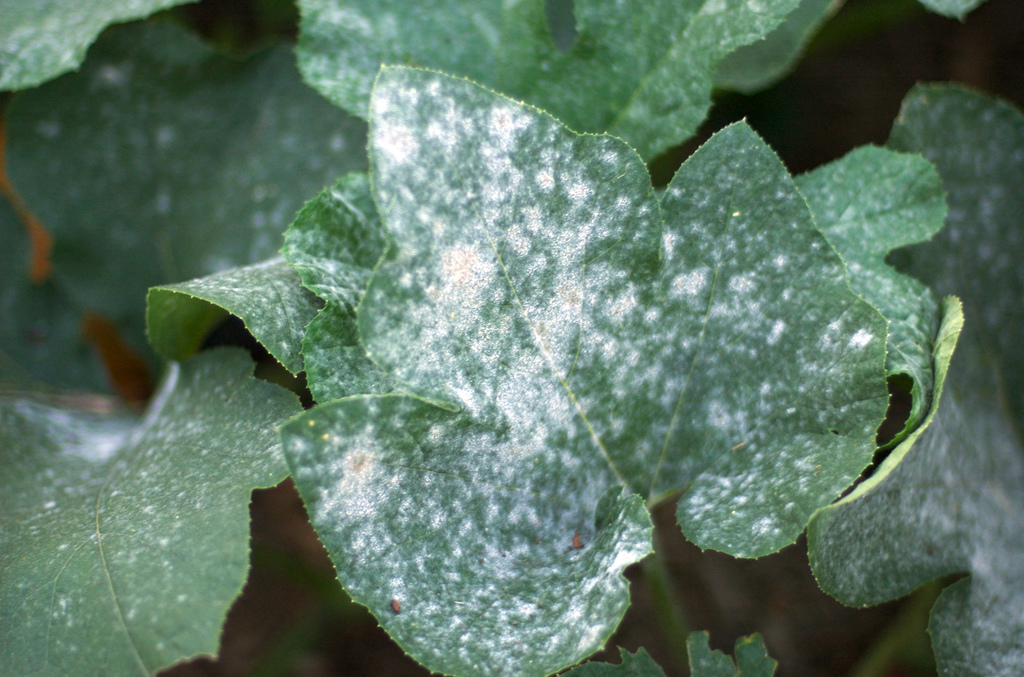Introduction
Powdery mildew is a fungal disease that affects a wide range of plants. It is caused by numerous fungi in the order Erysiphales, of which Podosphaera xanthii is the most frequently cited. Powdery mildew is one of the most recognizable plant diseases. It forms white, powdery patches on the leaves of infected plants. Powdery mildew seldom causes significant damage to host plants, though severe infections can reduce their ornamental value.
Distribution & Habitat
Powdery mildew affects plants throughout the United States. It occurs most often in environments with high humidity, and moderate temperatures.
Hosts
Powdery mildew infects thousands of plant species. The fungi that cause powdery mildew generally target specific hosts, and only infect plants from the same genus or family. Only a few species of powdery mildew fungi are capable of initiating infections in multiple plants. Many plants are susceptible to several different species of powdery mildew fungi. Trees and shrubs that are vulnerable to infection include apple, ash, azalea, barberry, birch, buckeye, catalpa, cotoneaster, crabapple, dogwood, elm, euonymus, hawthorn, ironwood, lilac, linden, magnolia, maple, oak, serviceberry, spirea, rhododendron, rose, and viburnum. Powdery mildew infections also occur on many different flowers, including African violets, begonias, English ivy, lilacs, kalanchoe, photinia, roses, snapdragons, and zinnias. Powdery mildew infections are common on many crops. Beans, cucumbers, pumpkins, tomatoes, squash, and zucchinia are especially prone to infection.
Disease Cycle
Wooly aphids, and other sucking insects are often vectors of transmission for powdery mildew. Aphids penetrate plant tissue where they often reside, and provide a host of potential inoculants through their secretions. Aphids are typically indicative of other plant problems. Powdery mildew fungi are parasites that require live tissue to grow and reproduce. The powdery mildew fungi can reproduce both sexually and asexually. Sexual reproduction occurs via chasmothecia, a type of ascocarp. Chasmothecium are dark colored, round fungal structures that contain spores. Each ascocarp contains several asci. As temperatures increase in spring, the chamothecium rupture, and expel spores that are disseminated by air currents or insects to host plants where they initiate new infections. The conditions necessary for spore matuaration differ amongst species. Some species of powdery mildew fungi overwinter as a dormant fungus, or mycelium, in infected plant parts. They become active in spring, and initiate new infections on emerging growth. The fungus develops on the growth, appearing as a white powdery mat on the leaf surface. Throughout the growing season, additional spores are produced and released. These spores cause new leaf spots to form on the host plant, and on neighboring plants. Powdery mildew thrives in humid conditions.
Symptoms of Infection
Powdery mildew infections are distinctive. Infected plants display white powdery patches on the leaves and stems. Lower leaves tend to be the most affected. As the disease progresses, the patches enlarge. An abundance of asexual spores are formed, and the mildew may appear on the rest of the plant. The first visible symptoms are raised blister-like areas on young leaves that cause them to curl, exposing the lower leaf surface. Infected leaves become covered with a white to gray powdery growth, usually on the upper surfaces. On plants that produce flowers, flower buds may become laden with mildew, and never blossom. The leaves of severely infected plants turn brown, and drop prematurely. Powdery mildew prefers young, succulent growth. Mature leaves are generally not affected.
Prevention & Management
- When planting, select resistant plants, and place them in sunny locations.
- Prune plants to promote sun exposure, and improve air circulation.
- Remove diseased foliage from infected plants. Disinfect pruning tools between each cut. Use a solution comprised of nine parts water and one part bleach.
- Maintain plant vigor through sound cultural practices. Ensure that plants are sufficiently watered, especially during extended periods of drought. Apply a layer of organic mulch around the base of plants to improve soil quality, moderate soil temperature, and retain soil moisture. Use a slow-release, organic fertilizer to feed crops. Avoid excessive nitrogen applications.
- Gently wash foliage occasionally to disrupt the spore-releasing cycle.
- Neem oil and PM wash can be applied on plants that are grown indoors. These will help prevent fungal infections.
- Chemical treatment of powdery mildew is possible. Fungicides are effective at combating the disease. Treat plants with a silicon solution. Silicon assists the plant’s cells in defending against fungal attacks by degrading fungal haustoria. Potassium bicarbonate and baking soda may also assist in treating powdery mildew infections.
- On select plants, such as summer squash, pumpkins, grapes, and roses, milk is an effective organic treatment. Milk is often applied to infected plants by home gardeners. Milk should be diluted with water, and sprayed on susceptible plants as a preventative measure, or at the first sign of infection. Repeated weekly applications can help control or eliminate the disease.
Photo courtesy of Jeff Kubina CC-by-SA 2.0.
